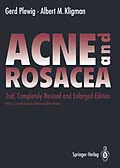"One Picture Is Worth a Thousand Words" CONFUCIUS The material on which this account is based derives from observations of several thousand of adolescents with acne. All have been treated; many hundreds have been biopsied and have participated in various tests. These constitute our bona fides. Our plan and intentions are as follows: Firstly, we have sought to create a portfolio of still-life pictures of the gross and microscopic anatomy of acne. This will be a photographic record of what acne looks like, of its usual and unusual features, its arch typical as well as of its recondite visages. Secondly, we wish to create a moving picture of acne rather than an atlas. We hope the reader will have the feeling of being in a theater watching an unusual drama. Since anatomy can only come to life when animated by physiology, a vigorous attempt has been made to collate function with structure. It is the eye that observes but it is the mind that sees. Finally, this book is intended for those who wish to understand and treat acne more effectively. The themes are programmed for the clinician. This book will be chiefly a didactic account and not a detailed report of research. We present ourselves as teachers, not as investigators. We conceive it to be the prime mission of medical research to learn how to identify, prevent, and treat the disease. We shall present our personal therapeutic strategies, the ones we use to treat acne patients.
Inhalt
Acne.- A Précis of Pathogenesis.- The Anatomy of Follicles.- Epidermal Lipids.- Sebaceous Glands.- Anatomy of Sebaceous Glands.- Physiology of Sebaceous Glands.- Methods of Measuring Sebum Secretion.- The Role of Lipids in the Pathogenesis of Acne.- Factors Influencing Sebum Production.- Microorganisms.- The Dynamics of Inflammatory Acne: Immunologic Factors.- The Evolution of the Comedo.- The Dynamics of Primary Comedo Formation.- The Dynamics of Secondary Comedo Formation.- The Cyst.- The Fistulated Polyporous Comedo.- The Draining Sinus.- The Dynamics of Inflammation.- Inflammatory Lesions and Sequels.- The Pustule.- The Papule.- The Nodule.- The Draining Sinus.- The Scope of Scars.- Classification of Acne.- Animal Models.- Syrian Hamster Model.- Rabbit Ear Model.- Rhino Mouse Model.- The Acnes.- Acne in Infancy.- Acne Neonatorum.- Acne Infantum.- Acne Conglobata Infantum.- Acne Venenata Infantum.- Steroid Acne in Infants.- Hippie Acne, Chap-Stick Acne, McDonald's Acne, and Kelp Acne.- Chloracne in Children.- Fetal Hydantoin Syndrome.- Androluteoma Syndrome of Pregnancy.- Acne Comedonica (Comedonal Acne).- Acne Papulopustulosa (Papulopustular Acne).- Acne Conglobata (Conglobate Acne).- Acne Inversa.- Acne Fulminans.- Solid Facial Persistent Edema of Acne Vulgaris.- Acne Mechanica.- Back Acne.- Acne Tropicalis (Tropical Acne).- Postadolescent Acne in Women.- Premenstrual Acne.- Postmenopausal Acne.- Masculinizing Syndromes in Women.- Androgen Excess in Men.- XYY Acne Conglobata.- Body Building Acne.- Acne Fulminans from Testosterone Therapy in Excessively Tall Boys.- Excoriations.- Acne Venenata.- The Occupational Acnes.- Acne Cosmetica.- Chap-Stick Acne.- Pomade Acne.- Chloracne.- Solar Comedones (Favre-Racouchot's Disease).- Acne Aestivalis (Mallorca Acne).- Radiation-Induced Comedones.- Acneiform Diseases.- Acneiform Eruptions.- Steroid Acne.- Amineptine Acne.- Rosacea.- Description.- Pathogenesis.- Clinical Findings.- Episodic Erythema (The Rosacea Diathesis).- Stage I Rosacea.- Stage II Rosacea.- Stage III Rosacea.- Variants of Rosacea.- Persistent Edema of Rosacea.- Ophthalmic Rosacea.- Lupoid or Granulomatous Rosacea.- Steroid Rosacea.- Gram-Negative Rosacea.- Rosacea Conglobata.- Rosacea Fulminans.- Phymas in Rosacea.- Histopathology.- Treatment.- Other Acne-Like Disorders.- Perioral Dermatitis.- The Role of Demodex.- Gram-Negative Folliculitis.- Acne Necrotica (Necrotizing Lymphocytic Folliculitis).- Sebaceous Gland Hyperplasia.- Trichostasis Spinulosa.- Steatocystoma Multiplex.- Eruptive Vellus Hair Cysts.- Dilated Pore.- Pilar Sheath Acanthoma.- Omphalolith: The Ugly Nabelstein.- Keratosis Pilaris.- Pseudofolliculitis of the Beard.- Osteoma Cutis and Pigmented Osteoma Cutis.- Minocycline-Induced Hyperpigmentation.- Therapy.- History of Therapy: Past, Present, and Future.- Treatment: General Statements.- Appraisal of Efficacy.- Topical.- Tretinoin (all-trans-Retinoic Acid, Vitamin A Acid).- Benzoyl Peroxide.- Miscellaneous Exfoliants (Peeling Agents).- Topical Antibiotics.- Azelaic Acid.- Systemic.- Antibiotics: Tetracyclines and Erythromycin.- Isotretinoin (13-cis-Retinoic Acid).- Vitamin A (Retinol).- Sulfonamides.- Sulfones (DADPS, DDS, Dapsone).- Estrogens and Oral Contraceptives.- Antiandrogens and Aldosterone Antagonists.- Corticosteroids.- Zinc.- Physical Therapy.- Ultraviolet Radiation.- Cryotherapy.- Abrasives.- ?-Hydroxy Acids: A Peeling Agent for Acne?.- Lasers.- X-Ray Therapy: A Historical Note.- Acne Surgery.- Dermabrasion.- Excision.- Punch-Graft Elevation or Punch-Graft Transplant.- Collagen Injection.- Silicone Injection.- Camouflage.- Psychosocial Aspects.- Spontaneous Involution of Acne.
